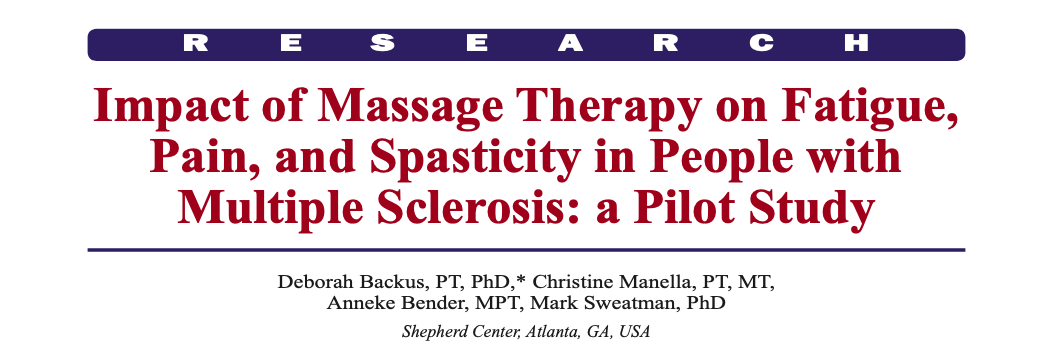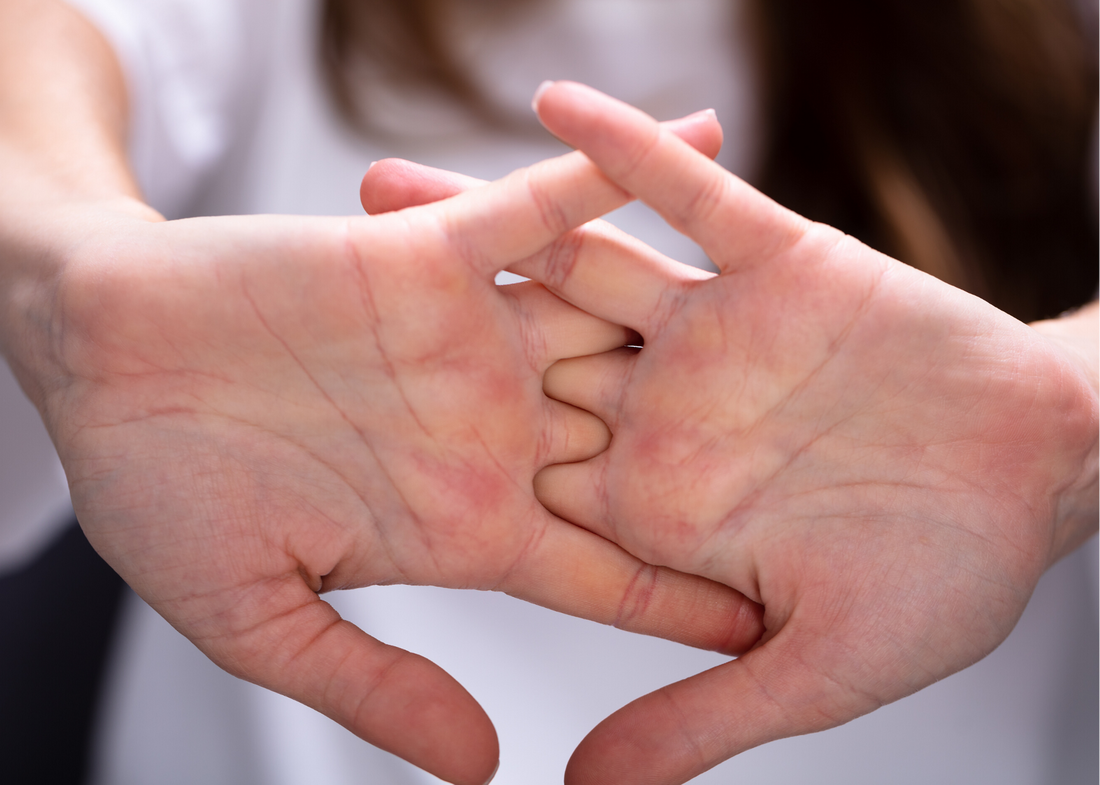|
Multiple Sclerosis is a many, many layered condition that has a long list of symptoms, including pain, fatigue, and weakness. There is currently no cure for MS. But just because there is no cure, does that mean there is nothing that can be done to help reduce these symptoms and maintain muscle health? From clinical experience, I've found massage and a variety of myotherapy techniques to be incredibly useful for patients living with MS. You can read more about my clinical experience with treating MS in this blog. I've been running for The May 50K during COVID19 isolation to raise funds and awareness for MS, so I thought its only fitting that I write up a bit of a literature review on the research! You can read the article here for the full study details, as published in the International Journal of Therapeutic Massage and Bodywork in December 2016. What does the research say specifically about massage therapy and MS?
There are a few things to keep in mind when we read this study. Firstly, manual therapies are hard to study, because the techniques used are almost always different every single treatment. As experienced therapists, we select techniques that are the most relevant to the patient each time they come for an appointment, and our selections are based off what we assess in the consultation, as well as what the patient agrees to on the day - for example, some days a deep pressure trigger point treatment can be tolerable and helpful, and other days it may feel too much. Secondly, Multiple Sclerosis affects people in widely different ways. There is no one "best" treatment technique for MS, and the symptom types, areas and intensity are vastly different from person to person. Keeping that in mind, lets have a look at how these researchers completed their study, and what they found. How did they design a study for massage therapy for Multiple Sclerosis? A specific massage sequence was designed for the study. This sequence was to be followed to the letter for every patient at every session, regardless of the symptoms on the day. This isn't an ideal way of providing a treatment in a clinical setting, however in a research setting its important to be able to make the tested treatment or therapy able to be reliably the same for every subject in the study. The sequence involved a full body massage therapy routine which included gliding strokes, kneading, cross fibre friction, and trigger point treatment. The 24 participants were scheduled for a weekly one hour treatment using the specific massage routine for 6 weeks. If a participant missed a scheduled treatment, they aimed to reschedule it within a week, so that each participant received 6 identical treatments over the course of no longer than 8 weeks. How did they measure and assess it? Five measurement scales were used to assess the outcomes in a variety of symptoms. The participants recorded scores for
What did they find out? The results overall suggested that massage therapy was a safe and useful tool in providing relief from fatigue and pain, and improving mental health and general quality of life. Fatigue - The MFIS indicated that 22 out of 24 participants reported decreased fatigue scores. There was a significant correlation between fatigue decreasing and pain decreasing. Spasticity - 19 out of 24 participants completed the MAS spasticity evaluation, and of these, 16 reported experiencing spasticity symptoms ranging from slight to considerable increase in muscle tone. There were no significant changes in spasticity after the end of the 6 week treatment period. Pain - On average, participants reported a significant 18% reduction in pain on the MOS Pain Effect Scale. The reduced pain scores correlated with improved mental health scores. Mental Health - A significant increase in the total scores on the MHI indicates overall mental health improvement. A small number of participants did not improve on some subscales, such as anxiety (3 participants) and depression (1 participant) Quality of Life - Overall, the quality of life scores on the HSQ showed improvement. Emotional and Social subscales showed more improvement than Health and Physical. The results indicated that as fatigue and pain decreased, measures of quality of life increased. Can we help you? Do you have MS and want to discuss treatment options? Our clinic is temporarily closed due to COVID19, but we expect to reopen by June. Check our availability on our online bookings page for updates. Are you receiving assistance from MS Employment Services? You may be eligible for funded Myotherapy treatment through your Occupational Therapist. Contact your OT to see if you can apply, and they will forward us the documents to begin the process for you. Do you have MS, you're currently working or seeking work, and you're not receiving assistance? Check the MS Employment Services website to see if you're able to receive support. We might not be able to see our MS patients face to face right now due to Covid19 restrictions, but thats not stopping us from helping in other ways!
We've created a team in The May 50K, which is a fundraising challenge to raise much needed funds for MS research. Our team is called Myotherapists for MS! The goal is to run 50km throughout May and raise donations and awareness to help support research for Multiple Sclerosis. What is Multiple Sclerosis or MS? Its a neuro-immune condition where the persons own immune system attacks their nervous system. It targets the myelin sheath, thats the insulating barrier between the nerve and its surroundings. Without myelin sheath, the nerve can't function in its usual way, and scarring (sclerosis) of the nervous system occurs. The normal nerve messages can get mixed up or lost, and it can cause a huge range of issues including:
Who are the Myotherapists for MS? Our team was created today by Mel and her good friend and mentor, Rhianna Bridgett. We're aiming to get a few more Myotherapists on board to help us stay motivated and to meet our goal of raising $1500 for MS. So far, the team includes:
Want to support us? Firstly, we all know and appreciate that these are hard times, the like of which most of us have never lived through before. So while donating is awesome, and we love and appreciate you if you are able to contribute a donation, its not the only way you can help our cause. What we would love to see more than anything is your support, inspiration and motivation! Basically - Keep us accountable! Make sure we complete our goals! Follow our journey on Facebook and boost our team morale by liking, loving, laughing at our posts, leave us a comment of encouragement, and share our achievements. Can you donate? If you can, we appreciate your support!! Want to know what your donation can achieve?
You'll also get a receipt automatically emailed out to you for tax time for any donation over $2 so you can claim the deduction. Go team!! Victorian Premier Daniel Andrews has announced an extended State of Emergency over the weekend, adding another month to the current COVID-19 situation. The State of Emergency has been extended to May 11th.
We’re now in Stage 3 Restrictions, and all Victorians are being urged by the Premier and the Health Department to stay at home when it is at all possible. Fines are being issued to people who are not adhering to the restrictions, including businesses and individuals. Myotherapy and Remedial Massage are currently listed as non-essential services, so our doors will remain closed a little longer. We also respect that so many of our patients are in high risk categories, so remaining closed at the moment is the most ethical action we can take to protect our vulnerable patients. This is a hard time for us as practitioners, as I’m sure its also a terrible time for people with chronic pain who are now unable to receive treatment as normal. AHPRA registered practitioners are still permitted to operate, so that includes practices that are covered under Medicare Benefits Schemes, like physiotherapy and acupuncture. Myotherapy is not currently part of AHPRA or Medicare. If you need urgent treatment, we encourage you to contact our friends Amanda at Upwey Acupuncture, or Travis and the team at Pathways Physiotherapy in Ferntree Gully. We will keep reassessing the situation as new information becomes available, however we don’t anticipate reopening before the May 11th State of Emergency period. Please keep safe and healthy as best you can, and know that we are looking forward to being able to announce our reopening date as soon as its safe to do so. We've all experienced a joint making a click, crack or crunch noise at some point. Some people much more than others. But what is it that causes a joint to become noisy like this? And does it spell bad news for your joints down the track? Cavitation - The Gas Bubble
Cavitation is normal and not dangerous. Most popping and cracking joint noises are likely to be caused by cavitation - that is, the formation of a gas bubble within the joint. Now you may have heard that joint noises are the popping of an existing gas bubble within the joint, however an interesting study published in PLoS One (Public Library of Science) in 2015 used real time visualisation of a joint under MRI to see exactly what occurs in the joint space when you crack a knuckle. What they found was that when the joint separated, it formed a bubble, rather than popping an existing bubble. Its called tribonucleation - this complicated sounding word describes the process of creating gas bubbles between two objects. It involves two solid surfaces that are covered in a liquid that contains dissolved gas. The surfaces resist being pulled apart because the liquid creates a suction effect, until enough force is generated to suddenly break the contact with each other, resulting in creating a gas bubble. In a joint, the solid surfaces are the two bones and articular cartilage surfaces that form the joint. The liquid containing dissolved gas is the joint fluid, called synovial fluid, that lubricates the joint surfaces to make it easy and smooth for the cartilage-covered bony ends to slide over each other. When a joint is put under enough force, the bony ends can be moved far enough from each other to break their contact momentarily, and cause that familiar pop noise. This can happen from purposefully trying to crack a joint, like cracking your knuckles, or from movements like squatting which can make your knees crack, or doing a spinal twist stretch which might crack your back either intentionally or unintentionally. People with hypermobility in their joints can experience a lot more popping and cracking noises than other people. This is because their joints tend to have more freedom of movement due to having stretchy ligaments so its easier for cavitation to occur. The role of ligaments is to connect the two bones of a joint together and keep it stable and stop the bony ends from separating. Will it cause arthritis? Its unlikely that cracking your knuckles and achieving that satisfying cavitation "pop" will cause you to develop arthritis in the long term, there are many more factors involved in developing arthritis. Movement of Tendons over Joints These sounds tend to be more of a snapping type of sound, because its the sound of the tendon moving over a bony area of the joint. Tendons are the strong connective tissue bands that connect muscles to bones, and for muscles to move a joint they need to cross over it. This means that sometimes the tendon will have to slide over a bony point where it will have to stretch like a rubber band to maneuver it, and will "snap" back due to elasticity of the tissue. Common snapping sounds from tendon movement can be heard in the knees, hips and shoulders. These movements shouldn't be painful, but if you do start to feel pain when you're hearing or feeling the movement of the tendon over your joint, get it checked out. Your myotherapist may be able to make a big change to the discomfort through simple muscle relieving techniques. Changes in Articular Cartilage Sounds from changes in articular cartilage tend to sound crunchy, crispy or "like gravel". Its called crepitus, but the sound is often worse than the sensation, and many people don't feel any pain at all. The term "bone on bone" gets thrown around, and this scares a lot of people because they visualise the bones literally grinding away at each other. The reality is that the ends of our bones are covered in articular cartilage, which is a smooth, squishy padding on the ends of bones that makes movement easy, fluid and painless and which prevents any direct "bone on bone" contact. Over a lifetime there will be normal changes to your cartilage, just like there is to a car, or a pair of shoes, or a well used garden pathway. Sometimes the changes in the cartilage can be that it becomes torn or damaged, for example if you have an accident, take a big impact to the joint, or get an infection. It can also build up over time from things like high intensity sports, repetitive use of the joint, or increased load on the joints from growing quickly or rapid weight gain such as pregnancy. Damaged cartilage can break down and remain in the joint space, which means the once-smooth surfaces become a bit rough, and there may be particles in the joint fluid. This can cause noisy movement of the joints, but its often painfree. Sometimes this can cause the joint to become irritated, which may cause it to swell up or become hot and inflamed, and then it can be temporarily painful. Do you need surgery? Many kinds of surgeries are used for joint problems, but not every person needs to go down the surgery avenue. Surgeries range from very short day procedures like arthroscopes which clean out cartilage debris in the joint space, to full joint reconstruction or replacement surgeries. Many people find they can prevent surgery for a long time with a tailored exercise program to strengthen the joint and reduce load on it, and using supports like braces or taping. Surgery is not guaranteed to fix the problem. Try your first treatment for $97 (normally $115) If you're having significant pain with your noisy joints, let us help - book an appointment with us today! |
Meet Our Team
We have a team of great practitioners available 7 days a week at our Rowville clinic. Archives
July 2024
Categories
All
|
Got a question about Myotherapy?
Contact Mel by phone, email or Facebook
|
Simple Wellness Myotherapy & Remedial Massage Clinic
Shop 12B 150 Kelletts Rd Rowville VIC 3178 |
Phone us on
03 8204 0970 |



 RSS Feed
RSS Feed